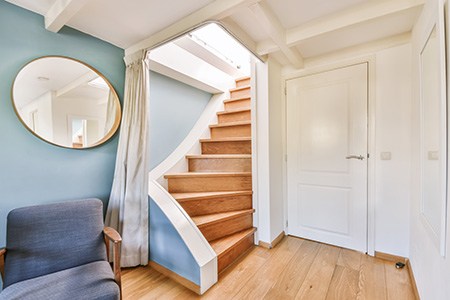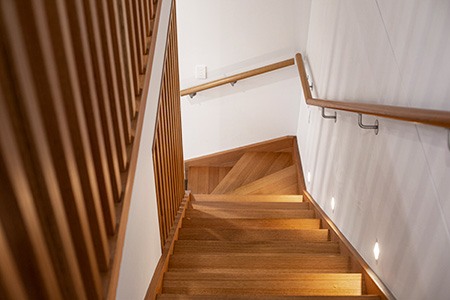How Many Steps in a Flight of Stairs on Average?
Author: Rick Worst | Editor: Omar Alonso
Review & Research: Jen Worst & Chris Miller

Have you ever found yourself climbing a set of stairs and wondered, "How many stairs are in a flight?" You're not alone! The number of steps in a flight can vary greatly depending on factors such as building codes, architectural design choices, and safety considerations.
In this informative blog post, we'll dive into the fascinating world of stair construction to uncover just how many steps you can expect in different settings — from residential homes to public stadiums — while also touching upon variations and exceptions to standard measurements.
Defining a Flight of Stairs: How Many Steps Should You Expect?
A flight of stairs is the number of steps between two floors or landings; on average, most flights consist of 10 to 12 steps.
Understanding the Components of a Flight of Stairs
A flight of stairs consists of several components that work together to provide a safe and efficient way for people to ascend and descend between different levels within a building or structure.
The steps are at the core, made up of risers and treads. Risers refer to the vertical portion connecting each step, while treads are the horizontal surfaces we walk on.
Staircase design also incorporates landings - flat resting areas found at specific intervals - allowing users to pause or change direction seamlessly during their ascent or descent. The types of staircases will influence the number of steps involved.
The stairway configuration can vary from straight flights, where all steps follow one continuous vertical line without changing direction, to more elaborate designs like L-shaped or U-shaped staircases incorporating intermediate landings for added safety and convenience.
Exploring the Average Number of Steps in a Flight of Stairs

A flight of stairs is a crucial architectural element in residential homes, commercial buildings, and public spaces.
To explore the average number of steps in a flight of stairs, we must first understand that each step usually has a rise of 7.25 to 7.5 inches and an average tread depth of 9.5 inches, as mandated by local building codes and the International Residential Code (IRC).
However, it is essential to note that these figures can vary depending on factors such as building regulations or design choices made by architects. For instance, while most flights have around 10-12 steps, some residential properties may choose spiral staircases with more compact designs requiring fewer steps per flight for space-saving benefits.
Similarly, larger commercial buildings might feature wider treads or longer landings affecting their flights' total number of steps. So, how many stairs are in a flight? Around 10 to 12 steps, total, for commercial and residential buildings of standard ceiling heights.
How To Measure the Number of Steps in a Flight of Stairs

The number of steps in a flight of stairs can be calculated straightforwardly by counting each step from the bottom to the top. However, if you want to calculate the number of steps based on the total height of the stairs or the height of each step, you can use the following steps:
1. Measure the Total Height: Measure the total height of the stairs from the base to the top of the stairway. Ensure that you're measuring from the same level as the base of the first step to the same level as the top of the last step.
2. Measure the Rise of a Single Step: Measure the height of a single step, known as the 'rise.' This is the vertical height from the top of one step to the top of the next step.
3. Calculate the Number of Steps: Divide the total height of the stairs by the rise of a single step. Number of Steps = Total Height / Rise of a Single Step
All of these calculations and measurements can be aided by the use of stair measuring tools.
Factors That Determine the Number of Stairs in a Flight

Building codes and regulations play a significant role in determining the number of stairs in a flight. Still, architectural design choices and safety considerations also impact stair count.
In order to learn more about how each factor contributes to the total number of steps, let's look at the different factors that determine the number of steps in a flight.
Building Codes & Regulations: What Are the Requirements?
Building codes and regulations are crucial in determining the number of stairs in a flight. These guidelines help ensure that staircases meet safety standards and provide adequate means of egress for occupants in case of emergencies.
One such widely followed guide is the International Building Code (IBC), which sets specific requirements for staircase design, including riser height, tread depth, stair width, and landings.
In addition to IBC recommendations, local jurisdictions may also have their own unique building regulations to accommodate regional factors or preferences. Therefore, when constructing or remodeling structures containing flights of stairs, it's essential to consult with local authorities responsible for overseeing compliance with respective zoning ordinances and building codes.
Architectural Design Choices: How Do They Impact Stair Count?
Architectural design choices play a significant role in determining the number of stairs in a flight. For instance, an open-tread staircase might require more steps to bridge the same vertical distance than a closed-tread one since each step covers less distance.
On the other hand, spiral staircases typically have fewer steps for the same height because they have tighter turns and smaller treads. Additionally, architectural features such as landings or platforms can break up long flights into shorter ones that are easier to navigate.
For example, some homes use alternating tread staircases with less floor space but require users to step differently than traditional staircases. Commercial buildings often feature grand central staircases designed for functionality and style—these frequently incorporate unique materials or shapes meant to impress visitors while still feeling safe underfoot.
Safety Considerations: Why Are They Important?
Safety considerations are of utmost importance in any stairway design. This is because stairways can pose a serious risk of injury or even death if they are not constructed with proper safety measures in place.
Building codes and regulations exist to ensure that the number of stairs, their height, depth, and width meet safety standards. Human factors such as fatigue, complacency, and stress can also significantly impact safety when using stairs or ladders.
Examples of Flights of Stairs in Different Settings

Large residential homes usually have an average of 13 to 15 steps in their staircase, while commercial buildings can have up to 30 or more, depending on the building's function. For more standard sized buildings, how many stairs are in a flight? Let's dig into the details.
Residential Homes: How Many Steps Do Typical Home Stairs Have?
In a typical residential building, you can expect the flight of stairs to have between 10 and 20 steps. The number of steps in a flight of stairs is determined by factors such as the height of each floor, which varies based on ceiling height and architectural design.
Commercial Buildings: How Many Steps Do Office Building Stairs Have?
Flights of stairs in office buildings typically contain 10-12 steps each, although this can vary depending on the building's characteristics. Building codes and regulations dictate the minimum number of steps for egress stairs to ensure safety measures are followed.
For example, some office buildings may have grand staircases that serve as design features or help create an open floor-plan concept. Meanwhile, other spaces may have steep winding stairs to create energy-efficient designs and require less floor space.
Public Spaces: How Many Steps Do Stadium Stairs Have?
Stadium stairs are popular for people who want to incorporate stair climbing into their workout routine. But how many steps do these flights of stairs typically have? Stadiums can vary significantly in size and design, but on average, most stadium stairs have between 30-50 steps per flight.
Aside from the fitness benefits, stadium stairs can be a fun and unique way to explore different parts of your city or town. Many stadiums offer public access during off-hours so that anyone can come in and tackle the challenging staircases.
Outdoor Staircases: How Do Outdoor Stairs Compare to Indoor Stairs?
Outdoor staircases differ from indoor stairs in several ways. The primary difference lies in their construction and materials used. Outdoor stairs are exposed to weather elements such as rain, snow, wind, and sunshine, which can cause them to deteriorate faster than indoor stairs.
Additionally, outdoor staircases require special attention when it comes to design considerations. For example, designers must ensure that the treads have enough traction even when wet or icy so that users do not slip and fall.
Examples of outdoor stairs include straight stairs leading up to a front porch or deck area and spiral or helix-shaped exterior stairways commonly seen in high-end luxury homes with multi-level gardens.
Variations & Exceptions to Stair Measurements

While building codes and regulations provide standard measurements for stairs, variations and exceptions are permitted in certain situations. Private steps or stairways serving a low occupant load may have exceptions to the code requirements for riser height and tread depth.
Additionally, architectural design choices can sometimes result in variations in stair measurements. Sometimes, designers may create an open staircase without risers or install spiral stairs instead of traditional straight flights.
It's also important to note that while handrail requirements are typically straightforward (one between 34-38 inches high), they can vary depending on local code interpretations and specific circumstances.
How Many Stairs Are in a Flight, Then?
So, how many steps in a flight of stairs are typical? In conclusion, understanding the number of steps in a flight of stairs is essential for safety and convenience. The standard flight of stairs consists of 10 to 12 steps, varying depending on the building codes, architectural design choices, and safety considerations.
Whether it's a residential home or commercial building, or public space, each setting has its own unique number of steps in its flights of stairs. So, how many stairs are in a flight? Usually, on average between 10 and 12 total.



